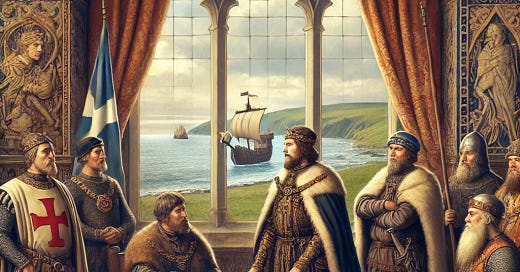Welcome back to "This Day in Scottish History." I'm your host, Colin MacDonald. Today, we travel back in time to September 8, 1468, a pivotal day that reshaped the map of Scotland and forever intertwined the fate of the Shetland Islands with the Scottish Crown.
On this day, a significant political and matrimonial arrangement took place, one that would result in the Shetland Islands being mortgaged to Scotland. This unusual financial arrangement was part of a marriage agreement between James III of Scotland and Princess Margrethe of Denmark, a union that was designed to strengthen the ties between Scotland and Denmark, two powerful kingdoms of the North Sea region.
To understand the importance of this event, let's first delve into the Shetland Islands' unique geographical and historical context. The Shetland Islands, often referred to simply as Shetland, are an archipelago located to the northeast of mainland Scotland, about 140 miles west of Norway. This remote yet strategically significant cluster of over 100 islands sits at the crossroads of the North Sea and the Atlantic Ocean, making it a coveted possession throughout history for various seafaring nations.
For centuries, Shetland was under the control of Norway, and its culture and language were heavily influenced by Norse settlers. The islands were known for their rugged coastline, rolling hills, and rich marine resources. The local population, whose lineage can be traced back to the Picts and later the Norse, developed a distinct way of life that reflected both Celtic and Norse traditions. The islands are steeped in history, with place names and cultural practices that echo their Norse heritage, such as the famous Up Helly Aa fire festivals and the Shetland dialect, a blend of Scots and Old Norse influences.
Now, let’s turn our attention back to the events of September 8, 1468. At the heart of this day’s significance was a dowry agreement. The future James III of Scotland was to marry Princess Margrethe, the daughter of King Christian I of Denmark, Norway, and Sweden. This marriage was not just a romantic union but a strategic alliance aimed at bolstering the political and economic interests of both kingdoms. However, there was a complication—the dowry agreed upon was significant, and King Christian I found himself unable to pay the full amount in cash. To cover the shortfall, he mortgaged the Orkney and Shetland Islands to Scotland for 8,000 florins.
Initially, this was meant to be a temporary arrangement. The islands were only mortgaged, not permanently ceded, and there was an expectation that they could be redeemed upon repayment. However, the debt was never fully settled, and the islands remained under Scottish control. Over time, this temporary mortgage evolved into permanent Scottish sovereignty, further solidified by subsequent treaties and geopolitical developments.
The mortgaging of the Shetland Islands had profound implications for the region and its people. The transfer of power marked the beginning of Shetland’s gradual integration into the Scottish realm. Over the centuries, the Scandinavian Norn language, once spoken by the inhabitants, was replaced by the Shetland dialect of Scots, and the islands' legal and cultural landscape shifted towards that of Scotland. Despite these changes, the Norse influence has remained a vibrant part of Shetland’s identity, visible in its traditions, architecture, and even local governance.
Today, Shetland remains an important part of Scotland, known for its stunning natural beauty, unique cultural heritage, and robust economy, which includes fishing, agriculture, and the oil industry. The islands' history as a pawn in a royal marriage reminds us of the complex web of political and familial alliances that shaped the medieval world.
As we reflect on the events of September 8, 1468, we are reminded of how historical turning points can hinge on seemingly routine diplomatic decisions—decisions that, like the mortgaging of the Shetland Islands, leave a lasting legacy on the cultural and political landscape.
Thank you for joining us on this journey through history. Tune in tomorrow for another enlightening episode of "This Day in Scottish History." I'm Colin MacDonald, wishing you a hearty "Haste Ye Back!"













Share this post